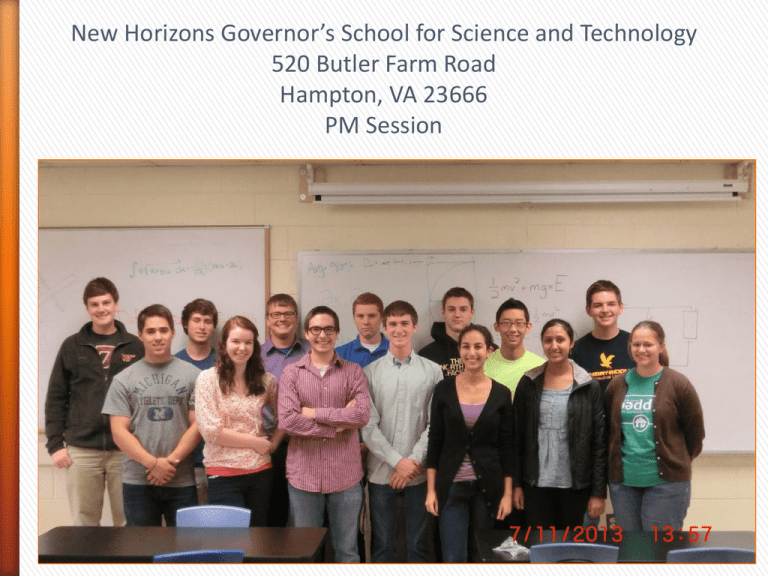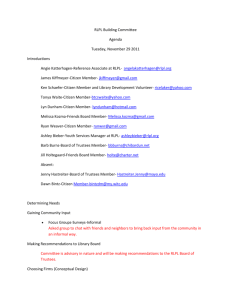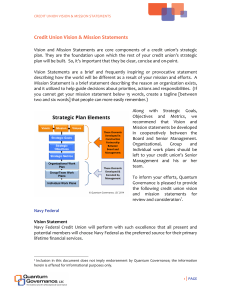Team Members
advertisement

New Horizons Governor’s School for Science and Technology 520 Butler Farm Road Hampton, VA 23666 PM Session Team Members: Sarah Selim-Project Manager- cyaselim@gmail.com Katie Jordan-Technology Team Point of Contact- kathleen.jordan@nhrec.us William Archer-Integration Team Point of Contact- williamrchr@gmail.com Sam Kim- Communication Team Point of Contact- sam211587@gmail.com Bethany Wissmann-Technical Team member- bgmwissmann@gmail.com Manisha Iruvanti- Technical Team member- miruvanti@gmail.com Scot Mackenzie- Technical Team member - scot1996@gmail.com Justin Cloutier- Technical Team member- justin.cloutier1@gmail.com Brady Reich- Technical Team member- breisch@cox.net Steven Haggard- Integration Team Member- c.stephen.haggard@gmail.com Correy Xu- Integration Team Member- correy.xu@gmail.com Richard Kazmer- Integration Team Member- richardkazmer@verizon.net Bobby Smyth- Integration Team Member- robert.smyth@nhgs.tec.va.us Danny McNamara- Integration Team Member- octoman115@gmail.com Eddie Schuler-Communication Team Member- eddieschuler@cox.net Team Descriptions: Technology Team1. Research and develop the process of Artificial photosynthesis. 2. Define the metrics and specifications of the experiment Integration Team1. Program the NESI Board 2. Begin programming tutorials in Python Communication Team1. Write the formal documents for the HUNCH program 2. Document progress of the team throughout the year Abstract: Artificial Photosynthesis in Microgravity The International Space Station (ISS) needs a more efficient way to supply oxygen for astronauts. Currently, the space station relies heavily on shipments of oxygen from Earth. However, this system has many flaws as it requires the astronauts essentially to ration their air. For many labor intensive tasks, such as repairing equipment or exercising, oxygen conservation adds unnecessary complexity and constraints. Also astronauts have complained about headaches and fatigue during group activities, when they produced too much carbon dioxide in a limited space. The need for a system to produce breathable air is important also for future long-term space explorations. Green plants in a natural process could supply oxygen. However, this approach entails the astronauts to tend to the plants and risks introducing additional microbes to the ISS or other planets. Artificial photosynthesis, an oxygen-producing chemical process that replicates the natural photosynthesis of plants, can provide a better solution. Artificial photosynthesis has been demonstrated in laboratory settings using a variety of designs and several different catalysts. The challenge will be to select, design and build a container to house the system, and monitor the performance in microgravity. Computer Power PicKit Programmer On/Off Memory SD Card Code Data Emergency Shut-off Over 120 Degrees F NESI Board Fan Temperature Sensor Pressure Sensor Accelerometer Water Level Sensor Storyboard FOR ISS AUTOMATED EXPERIMENT Measure oxygen and carbon dioxide levels – every second (I/O) Start electrolysis – “if” statement: when oxygen concentrations below certain level Wait 1 minute Turn fan on – constant (I/O) (Circulate oxygen) Measure water content– constant (I/O) (How often does the water need to be refilled?) Measure temperature – every 5 seconds (I/O) Measure pressure in apparatus – every second (I/O) Repeat Precautions – Emergency cut-off (Circuit Breaker) FOR VOMET-COMET EXPERIMENT Turn on – Start Electrolysis Wait 1 minute Measure oxygen and carbon dioxide levels – every second (I/O) Turn fan on – constant (I/O) (Circulate oxygen) Measure water content– constant (I/O) (How often does the water need to be refilled?) Measure temperature – every 5 seconds (I/O) Measure pressure in apparatus – every second (I/O) Repeat Power off Precautions – Emergency cut-off (Circuit Breaker)







